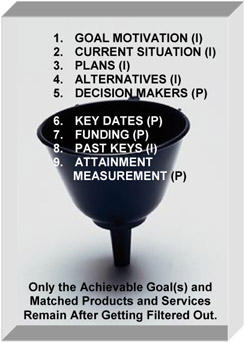Filters Must Measure Up
You probably can list dozens of circumstances that influence your and your customers' ability to achieve their goals. So, which ones do you choose to consider and which ones do you toss out? Again, you resort to the powerful business axiom: "You can only manage what you can measure.'' When you start reevaluating the circumstances on your list in terms of whether you can measure their effect, it starts shrinking dramatically.
Nine purchasing considerations or filters pass this test of measurability. These so-called filters earn their name because they filter out what goals (if any) customers can achieve. They also filter out what products (if any) can achieve those goals. Filters provide you with information about the unique circumstances of each customer and the constraints under which he or she operates in making purchasing decisions. Without measurable goals and filters, it becomes anyone's guess whether customers or you can achieve their goals.
It is essential to ensure that customers' goals are not merely wish lists. Although you can measure customers' filters, like goals, they usually do not start out seeming measurable. You need to convert them from broad concepts to measurable ones. Chapter 5 discusses in detail the mechanics and techniques behind making goals and filters measurable through active listening and questioning. Once measurable, these nine filters enable you and customers to conduct tests of reasonableness to determine whether their goals are achievable. These tests then determine if sales opportunities are worth further investments of time, energy, and resources. (When they are not worthwhile because sales opportunities will be price or delivery driven, or customers' goals are not achievable, then nothing ventured is everything gained.)
| Note | By agreeing to discuss the details of their filters, customers are expressing a desire to find out whether they can achieve their goals. They are acknowledging that the possibility of achieving their goals is worth the additional effort to sweat the details of their filters. |
Prerequisites and Influencers
It is easier to understand filters by dividing them into two categories: prerequisites and influencers. Prerequisites are exactly what their name implies. Customers and you must satisfy these filters to achieve their goals through your products. No leeway exists. Consider them purchasing constraints or "hard'' filters. You can probably do an excellent job of finding out three of the four prerequisites. Yet, as you will see, the fourth one is the key to the sale.
Influencers, as their name implies, influence the customers' and your ability to achieve their goals. Customers might or might not consider them when deciding to pursue goals or buy your products. While they are measurable and motivate customers to act on their goals and your products, these five filters are not requirements of the sale. View them as peripheral issues or "soft'' filters. You can probably do a great job finding out four of the five influencers. However, the fifth one affects the outcome of sales almost as much as prerequisites do.
| Note | Filters are to goals as features are to benefits. Always think of them together. Every filter links back to the customer's goals to measure its effect. In addition, whether you find them out or not, filters work behind the scenes to affect the outcome of every sales opportunity that you encounter. |
A Quick Snapshot of the Nine Filters
The order in which filters surface changes on every sales call based on customer responses. When they surface is not important (as long as it occurs before you mention specific products). What is important is that you make them measurable when they do surface—and that you find out as many of the nine as possible.
In the following list, the letter P stands for "prerequisite'' and the letter I stands for "influencer.'' The nine filters are as follows:
-
Goal Motivation (I). Why does the customer want to achieve his goals?
-
Current Situation (I). What is the customer presently doing to attempt to achieve his goals?
-
Plans (I). What does the customer want to do in the future to achieve his goals?
-
Alternatives (I). What courses of actions, besides using your products, does the customer have to achieve his goals?
-
Decision Makers (P). Who are the people involved with making the purchasing decision on achieving these goals?
-
Complete, Start, Budget, and Decision Dates (P). What is the customer's time frame to complete, start, budget for, and decide on these goals?
-
Funding (P). How will the customer pay to achieve these goals?
-
Keys to Previous Successes/Failures (I). What past projects were successful or unsuccessful in achieving similar goals and why?
-
Attainment Measurement (P). How will the customer measure whether his or her goals were attained?
| Note | All the filters end with a reference to goals. Your questions about filters should reference their goals also as you will see in Chapter 5. |
Do not think of this list as a set-in-stone sequence. Salespeople often find it easier to start with the influencers to build credibility. Once customers realize you are seeking information to help them better understand their ability to achieve their goals, details of the prerequisites flow freely.
Once you know these filters, you and customers determine:
-
Whether their goals are attainable.
-
If your products achieve their goals.
-
What would need to change—goals, filters, or the product—to make it all work?
Think of filters as a sieve. The customers' goals go into the top of the sieve. The filters then act as strainers. By the time you and customers come out the bottom of the sieve, only the goals customers can achieve and the products you can offer remain. (See Exhibit 4-1.)

Exhibit 4-1: Filters are like sieves.
EAN: 2147483647
Pages: 170